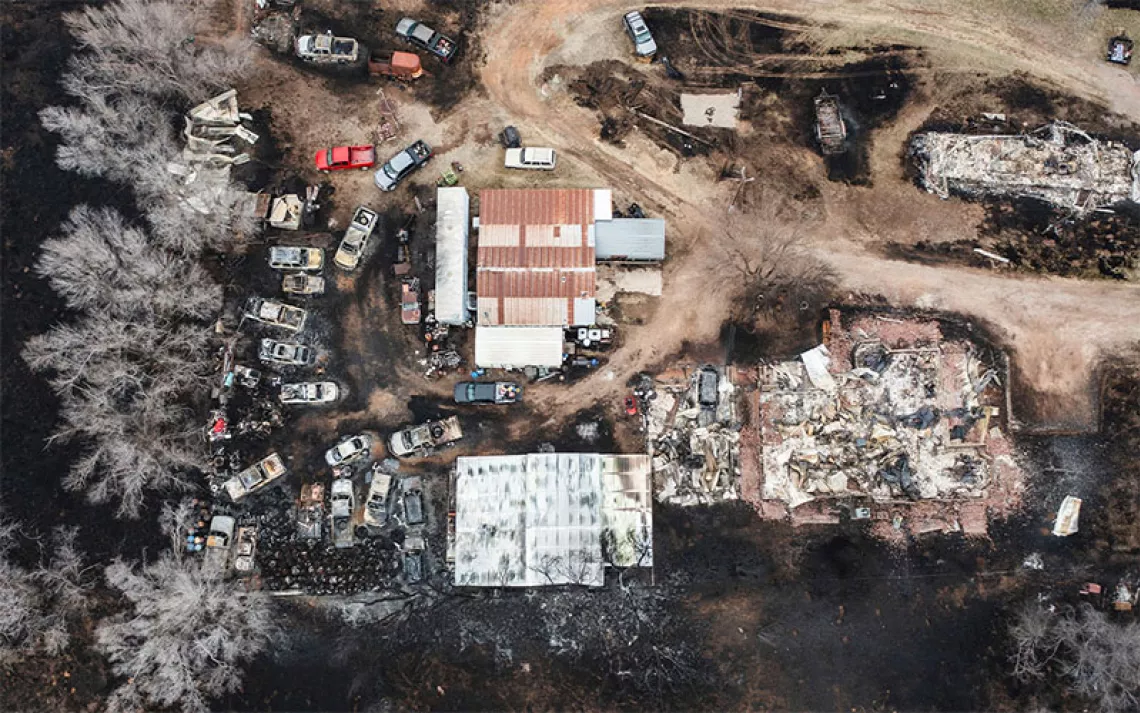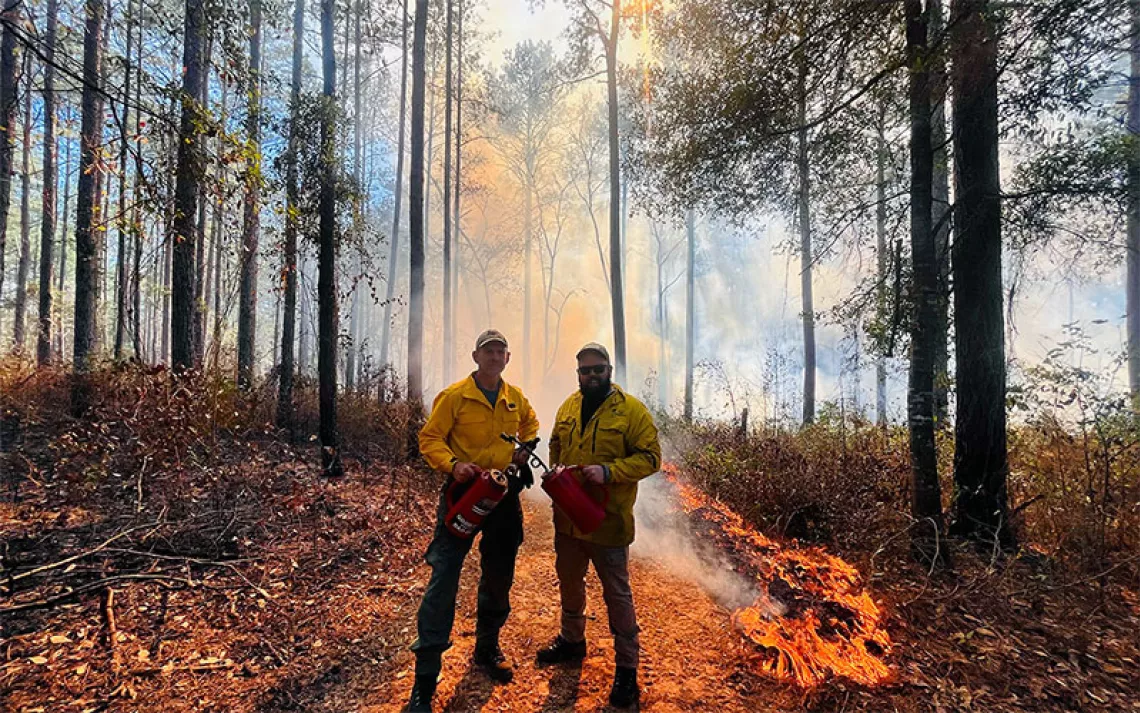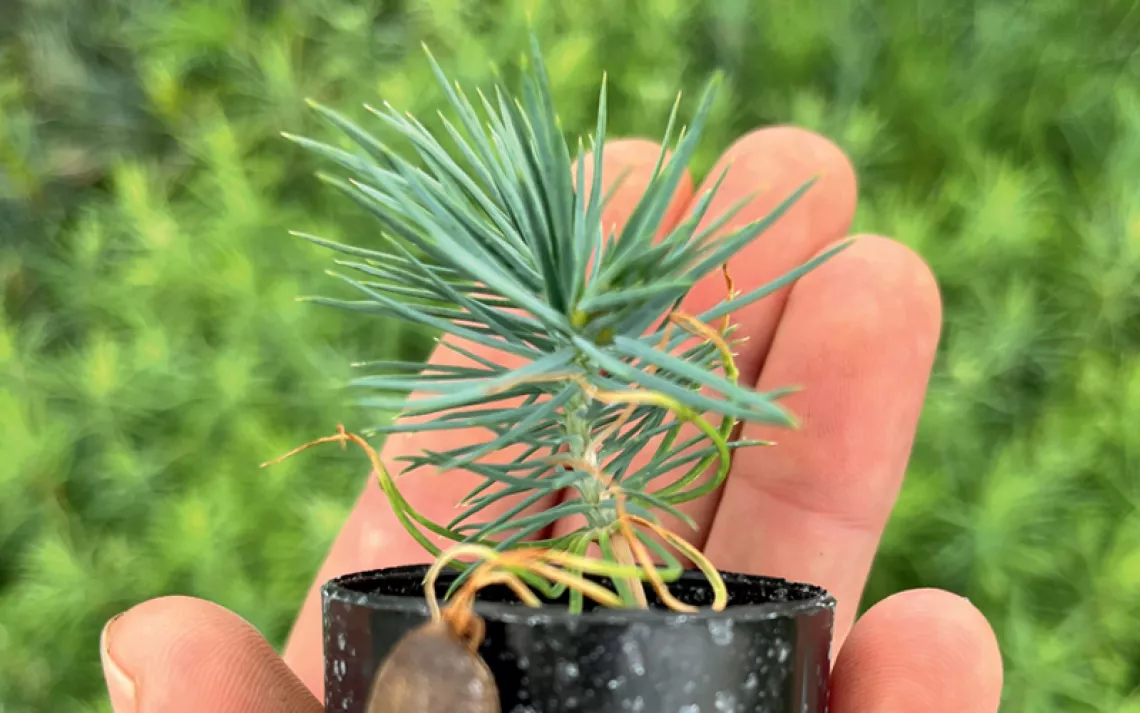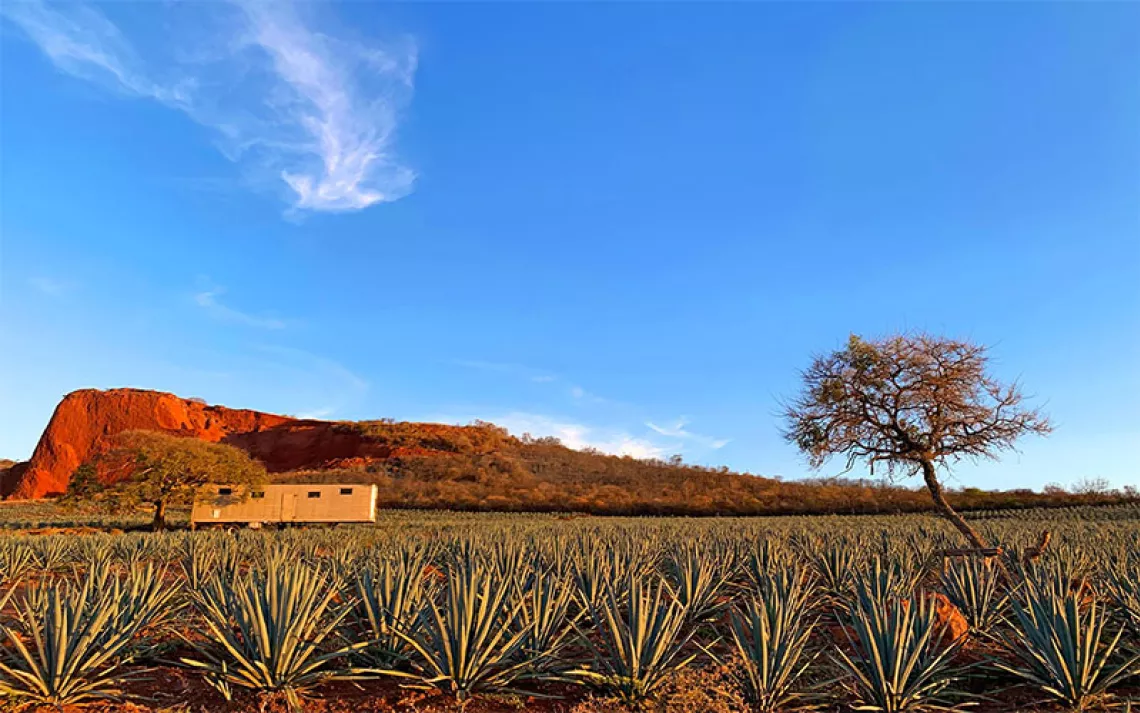The Creek Fire One Year Later
A dispatch from the front lines of the climate crisis
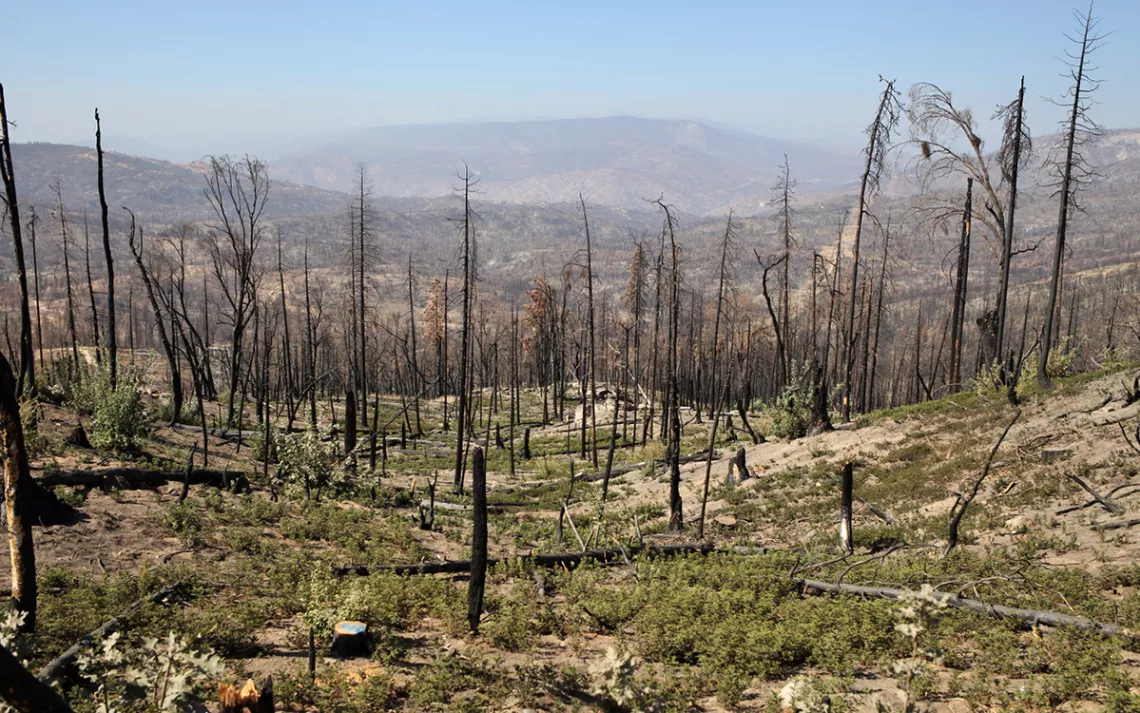
Photos by Jeremy Miller
Steve Haze stood on a pullout on Auberry Road, near the small town of Pine Ridge, in the foothills east of Fresno. He pointed to a yawning panorama of charred trees—the remnants of last year’s devastating Creek Fire. Beyond the burned forests stood the high peaks of the Sierra Nevada, which could just be made out through a veil of smoke.
Haze, the district manager for the Sierra Resource Conservation District, held a white binder. It was filled with color-coded maps covered in red and green circles. The red circles represented structures that had been destroyed in the blaze; the green circles, ones that had been spared. A quick glance revealed as many red circles as green ones. “The fire moved so fast,” Haze said. “In some places, there was no time to react. People had to just pick up and go with almost no warning. We’re lucky no one died.”
The Creek Fire began on September 4, 2020, most likely triggered by lightning in the tinder dry conifer forests in the Big Creek watershed, a tributary of the San Joaquin River. Fueled by heavy winds, the fire rapidly transformed from a small blaze into a massive inferno and threw a huge cloud of ash tens of thousands of feet into the air. The Fresno Bee aptly compared the towering, fire-generated pyrocumulonimbus to “the aftermath of a nuclear explosion.” By the time it was fully contained more than three months later, the Creek Fire had destroyed more than 850 structures and charred more than 379,000 acres, an area twice the size of New York City.
Until it was surpassed this year by the Dixie Fire, the Creek Fire was the largest single blaze in California history. In this era of climate disaster, one event—megafire, storm, or flood—seems to blur into the next. Records fall. Lives are shattered. Human suffering compounds. Meanwhile, outside the disaster zone, it’s often difficult to take account of the profound changes sweeping the planet, to track the mounting damage in communities flung across the advancing front lines of climate change. It’s become all too easy to forget.
But for the victims of the Creek Fire, there is no forgetting. A year later, the disaster continues. Hundreds remain displaced as the community tries to inch its way out of the aftermath. Haze has been at the center of that effort, helping residents secure financial and material resources to get back on their feet while also tending to environmental concerns. He suggested that we visit the town of Shaver Lake, where residents were gathering for a one-year anniversary commemoration. The town, situated in a forest of sugar and ponderosa pines, was spared. But the surroundings, particularly around its namesake lake, a haven for summer recreationists, were devastated. The intensity of the fire was captured on video by visitors forced to take refuge on a boat as flames encircled the mountainsides.
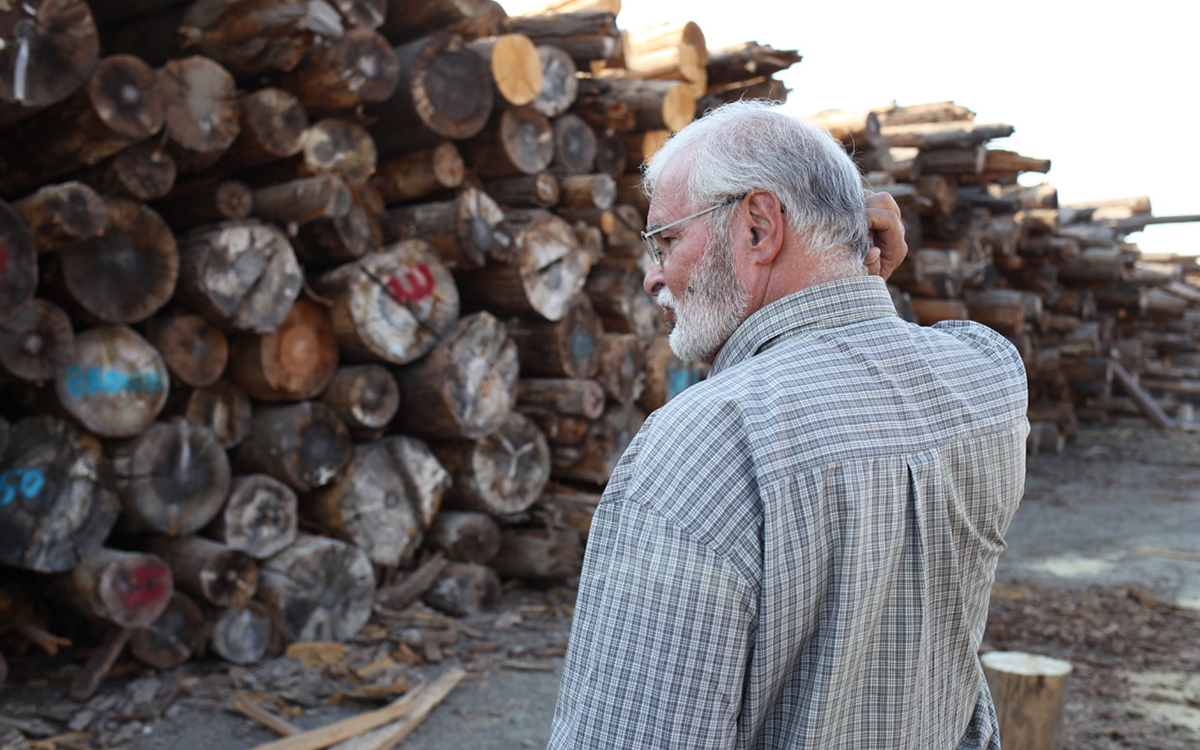
When we arrived at the gathering, which was being held on the community baseball field, country music was playing. Several hundred residents milled around kiosks selling food; tents were staffed with representatives from numerous governmental agencies and nonprofit organizations that have assisted in the relief effort. A haze from distant forest fires was visible in the distance—a grim reminder that the next fire could be a mere spark or lightning strike away.
Among those in the crowd was Shaver Lake assistant fire chief James Parr, who recounted the scene last September. At nearly every turn, he said, the fire defied expectations. “The fire started in the wrong place and went in the wrong direction,” said Parr. “It went completely against everything that we’d prepared for.”
Parr said that a mixed crew of firefighters from Cal Fire, Cal Office of Emergency Services, and other municipal departments had massed at the Cressman Store, near the summit of Highway 168. The 115-year-old structure had survived other fires and most assumed that the store was a safe place to establish a base of operations. “There were seven engines there, tons of water and lots of people, ready to go,” he said. “And when the fire came, they were there for like 15 minutes before they ran. There were 200- and 300-foot flame heights on 100-foot-tall trees. There were 50-mile-an-hour winds that were fire-driven. There was no manmade force that was going to stop that.”
The conflagration spared nothing in its path—including Parr’s home. He said he learned that his house had been lost while marking an escape route that passed through his neighborhood. “Since I was the local guy, I was putting cones on the road to show the way out,” he said. Then a voice came over the radio: The fire has taken Cressman Road, and it has jumped the highway. Parr went down the road as far as he could to a familiar vantage point overlooking his home.
“It was just red sky.”
Even a year after the disaster, the trauma of that day remains fresh, said Tanner Michaelson, a disaster case manager at Catholic Charities, which is assisting around 100 families among the FEMA-estimated 2,000 survivors of the Creek Fire. “It has been very hard to get victims to accept the loss, to accept the situation, and to acknowledge that there is really only one direction that we can move in and that is forward.”
Some are attempting to help the community recover through the collective power of storytelling. Kristin Telles, a councilmember with Central Sierra Resiliency Fund, is collecting stories from survivors as part of the Creek Fire Storytellers Project. “We think it’s important both to preserve the historical memory of what’s happened here and to give people a chance to share their stories,” Telles said. “We think it is very therapeutic to have that opportunity, to see that there are some similarities in those experiences and emotions.” Telles said each story is unique but that they have common elements: Along with a sense of optimism about the future, she said, most of them include some version of the idea that “I didn’t think it could happen to me.”
Others were thinking about ways to heal the landscape. Resident Julianne Stewart handed out sugar pine seedlings, each no more than a few inches tall. Stewart, a registered forester who founded her own consulting firm in 2014, told me that she believes that region’s fire risk is largely the product of harmful land management practices that have excluded fire from the landscape. “The catastrophic impact that this fire had is directly tied to our land management over the last hundred years,” she said. Climate change, she believes, has played a role—albeit a smaller one than aggressive fire suppression. “Step one is looking at a piece of land and addressing the fuel loading, getting the dead trees down, and replanting native conifer species. A lot of money needs to go into bringing this forest back.”
As I spoke with Stewart, a tall man in a mask and a wide-brimmed hat approached the kiosk and gently rebuffed the idea that the community would be able to plant or log its way out of the disaster. “You can go out there and plant more trees, but you can’t draw more rain down,” he said. His name was Howard Hendrix. A long-time English professor at California State University, Fresno, Hendrix has served for several years as the president of the Highway 168 Fire Safe Council, a grassroots organization that helps members of the community create defensible space and take other measures to prepare their homes for wildfires. “We did everything we were supposed to,” Hendrix said. “Our houses were far apart. We had metal roofs. We had fiber cement siding. We had removed trees and were in a fuel break. It was still destroyed.”
When Hendrix was finally able to return to his property days later, he found strange globs of metal on the ground. It took him a few minutes to realize that these were the remnants of his pickup truck’s aluminum engine block. “Aluminum melts at 1,200 degrees Fahrenheit,” he said. “These are fires like we’ve never seen.”
I asked Hendrix if he plans to rebuild. “My wife is not fond of the idea of rebuilding in a burn scar,” said Hendrix. He also said they have been embroiled in a 10-month fight with their insurance company, which offered a fraction of the pre-fire estimate of their home. “They offered us $20,000 less than what it cost us to build the house 15 years earlier.… This is the disaster after the disaster.”
Haze and I left the event and drove west out of Shaver Lake, touring a section of the Creek Fire that had burned intensely (the area where Parr's and Hendrix’s homes once stood). As we drove, I turned on my radio and listened to a constant stream of climate catastrophe. One story told of firefighters drilling through a bridge in New Jersey to rescue a man from floodwaters after a record storm that struck the East Coast. Another recounted the evacuation of a Louisiana retirement home in the aftermath of Hurricane Ida.
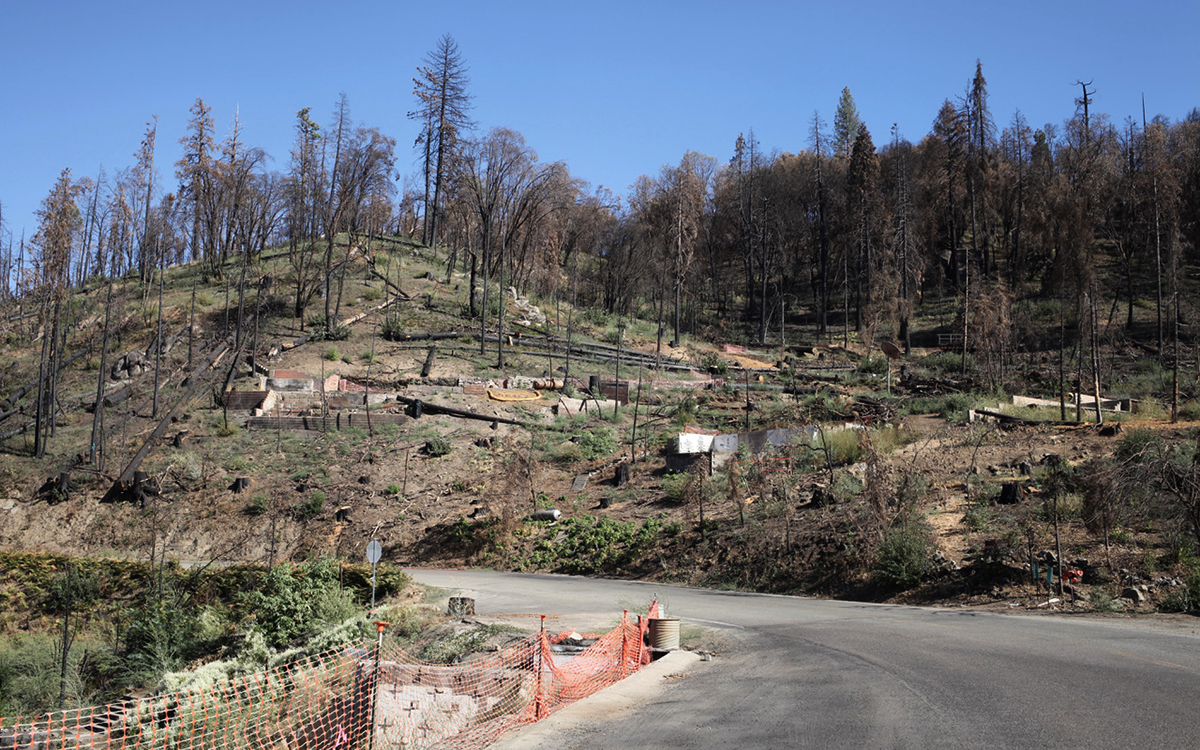
We traveled along a rugged hillside, through a seemingly endless landscape of charred ponderosa pines and incense cedars. Fire-scourged foundations and lone chimneys dotted the landscape. Near the town of Alder Springs, the fire had burned ferociously up a steep mountainside, leaving blank terraces where a dozen or so houses once stood. Here and there green leaves punctuated the charred understory. These were the first inklings of black oaks, which, in the absence of a tall canopy, had begun opportunistically sending up shoots.
In the distance, through hundreds of acres of fire-razed forest, it was easy to fathom the human influence on the landscape. Roads crisscrossed the mountainsides. Houses clung to granite precipices. Power lines ran in all directions. From our vantage, it was clear that the wildland urban interface (WUI) was far more than a simple boundary—it was an unruly border that stretched far into the rugged hinterlands. “An ‘interface’ implies a straight line,” said Haze. “But that’s too simple. I call it the ‘wildland urban intermix.’ There’s a house over here and one way over here, and there’s an inholding over here, and they’re all connected by networks of roads.”
We dropped down a steep grade, pressing deeper into the WUI. That no one perished on these narrow, winding tracks during the evacuation is truly astonishing. From the main road branched private drives posted with no-trespassing signs and strung with yellow caution tape. Haze said that we needed to be careful not to be perceived by property owners as “looky-loos.” Once while touring the fire zone, a resident pulled a gun on him, even though his truck bears a prominent SRCD decal. “People are hurting,” he said. “The experience is still very raw.”
We drove farther on and arrived at a group of several modern wooden houses set off in the forest. They were unscathed. In the months before the blaze, Haze secured a federal grant to assist residents in removing massive “decks” of beetle-killed trees scattered about the forest. The most concerning of these flammable piles were the ones that sat adjacent to houses. “It was tinder just waiting to burn,” said Haze. “Unfortunately, we weren’t able to get all the logs out. But the ones that we were able to remove helped some of these houses survive.”
But where did the logs go? Haze wanted to show me. We drove west out of the mountains, onto the valley floor, to a parcel along the banks of the San Joaquin River owned by the state of California’s San Joaquin River Conservancy. Haze unlocked a gate, and we rattled along a dirt road that snaked along the banks of a deep quarry. Ahead loomed a massive bulwark of timber, easily 100 yards long and 20 feet high.
Each log had been hauled down the mountain on the back of a truck and was coded with spray-painted numbers and names corresponding to the property from which it had been removed. One read Parr; another Hendrix. The hope, said Haze, is that the non-merchantable timber can be used for various purposes—from providing lumber for construction projects on public lands to restoring degraded soils along the San Joaquin.
I asked if this was our only choice at this late hour—to log our way out of our extreme fire risk? And wasn’t this huge pile of wood, now languishing in the 100-degree heat of the valley, creating a new fire hazard in a different place? “We have to deal with what we’ve inherited,” Haze replied. “We’re now part of the natural cycle. We’re part of it whether we like it or not. And we have to figure out a way to manage it.”
 The Magazine of The Sierra Club
The Magazine of The Sierra Club
